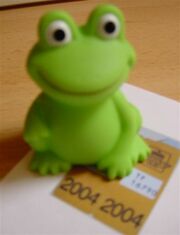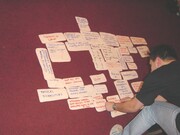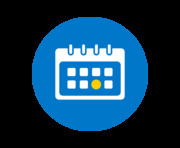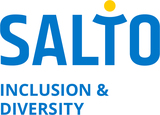Labeling & Portraying people with a Disability
It is rather lengthy to refer to "people with a disability" - talking about e.g. "a quadriplegic" (one word) would be easier and shorter. However the words we use determine how we see people (and consequently approach them).
- Find this and more in SALTO's Inclusion for ALL booklet: No Barriers, No Borders
Some Language & Portrayal Tips
A reason why people have pitying attitudes and uncomfortable behaviour towards disability could be because there is little positive and authentic media coverage of people with a disability and few respectful examples of addressing and portraying this target group. So if you are sending out signals into the world (talks, articles, pictures, TV, radio, applications,...), you might consider the following tips
- Put people first, not their disability. Emphasize the people, not the labels. Do not use a disease or disorder to refer to people. This puts the focus on the individual, not the particular functional limitation.
| Out | In |
|---|---|
| The disabled | People with a disability |
| Birth defect, congenital defect, deformity | Person born with a disability, person who has a congenital disability |
| The blind, Visually impaired | Person who is blind, person with a visual impairment or who is partially-sighted |
| Hard of hearing, hearing impaired | Person who is hard of hearing |
| Deaf-mute, deaf and dumb | Person who is deaf |
| The epileptic | Person who has epilepsy |
| Learning disabled, learning disordered, the dyslexics | Person with a learning disability Person with dyslexia |
| Spastic | Person who has spasms |
| Victim of cerebral palsy, multiple sclerosis, arthritis, etc. | Person who has cerebral palsy, multiple sclerosis, arthritis, etc. Person with a disability. Person with a mobility impairment. |
^^ top ^^
- Show people with disabilities as active participants of society. Portraying persons with disabilities interacting with non-disabled people in day-to-day social and work environments helps break down barriers and gives a good example of positive and respectful interaction. Using images that isolate or call special attention to persons with disability is only appropriate if it is relevant to the story.
- Update your vocabulary. The way we refer to persons with a disability has changed over time but some people still use archaic terms (which were used last century!). Avoid using old derogatory terms.
| Out | In |
|---|---|
| handicap(ped) - it comes from the times when persons with a disability had to go with the "cap in the hand" on the streets to beg for food and money to survive | Disability - person with a disability |
| Invalid - the literal sense of the word "invalid" is "not valid" | Person with a disability |
| Fit, attack, spell | Seizure |
| Cripple, crippled, lame | Person with a mobility impairment, person who has a spinal cord injury, arthritis, etc. |
| Insane, lunatic, maniac, mental diseased, crazy, demented, deviant, psycho | Persons with a mental health/psychiatric disability, person who has schizophrenia, person who has depression |
| Mentally retarded, defective, feeble minded, idiot, imbecile, moron, retarded, simple, mongoloid | Person with an intellectual disability, person with Down's Syndrome |
^^ top ^^
- A bit of pity for the disabled... Do not focus on disability unless it is crucial to a story. Sad human interest stories about disability might get you the pity (and alms) of some people but will surely not change the patronising attitudes of people towards people with a disability. Focus instead on issues that affect the quality of life for those same individuals, such as accessible transportation, housing, employment opportunities, and discrimination.
- Emphasize abilities, not limitations. Assistive technology (wheelchairs, crutches,...) enables people with a disability to take part in society, rather than limiting them.
| Out | In |
|---|---|
| Confined to a wheelchair, wheelchair-bound |
Person who uses a wheelchair (a wheelchair is a means to get around independently) |
| Patient (only in relation to a doctor) | Person |
| Handicapped parking, bathrooms | Accessible parking, bathroom |
- People with disabilities are not (always) super-heroes. Even though the public may admire super-achievers, portraying people with disabilities as superstars raises false expectations that all people with disabilities should achieve this level. It is probably the 'typical' people who have a disability that we want to put in the picture.
- Avoid artificial or ridiculous euphemisms. Using euphemisms to describe disabilities is likely to put people in an uncomfortable or patronising situation in which they do not interact "normally" with persons with a disability, but instead be weary about using the most hilariously politically correct term. Let's call a spade a spade.
| Out | In |
|---|---|
| Differently abled | Person with a disability |
| Physically challenged | Person with a disability, person with a mobility impairment |
| Mentally challenged | Person with a mental/intellectual disability |
| Vertically challenged | Person of short stature |
| Visually challenged, hard of vision | Person with a visual impairment or who is partially-sighted |
^^ top ^^
- Often when the theme of disability comes up on TV, in public, in the theatre, etc., actors or models without disabilities are used to represent persons with disabilities. Why not use actors or models with disabilities to portray persons with disabilities?
- A little dose of sensationalism? Avoid negative terms or emotionally laden words to refer to people with a disability. These terms portray the assumed sensation and drama of having a disability (which is not necessarily correct). They will only get you pity or amazement instead of positive attitudes and respectful interaction with people with a disability. Most of the outdated terms above also belong to this category.
| Out | In |
|---|---|
| Suffers from, afflicted by, stricken with | Person with a disability, etc |
| victim of x | Person with x |
| Pitiful, sad, ... |
- Having a disability is not synonymous with suffering. Persons with a disability can have a perfectly happy life, with ups and downs like anybody else.
- What to use to refer to people without a disability? One word to avoid is 'normal', as the situation the persons with a disability are in is perfectly normal for them. So we would use 'people without a disability' or the 'non-disabled person' (but you might want to put the person first?)
- It is generally OK to use usual expressions such as "you see?" or "see you later" when a blind person is around, or "let's walk to z" with a person using a wheelchair, etc. Don't get paranoid about what you can say and what not - the persons with a disability can indicate what they take offence at and what alternatives they prefer.
- As mentioned before, persons with disabilities are a very amorphous group, so it is difficult to refer to "them" or "they" as the individuals are very different from one other.
Note!
Having said this, we shouldn't try to be 'more catholic than the pope' in our political correctness either and ask the persons in question how they want to be referred to. e.g. in the training field the word 'brainstorm' was put on the black list because it is a condition that persons with epilepsy go through during a seizure. Instead one should talk about "idea generation" or "thought showers". A colleague trainer - who has epilepsy - laughed out loud when he heard this and is big into using the word 'brainstorm' in his training sessions - just to make a point.
Conclusion: if not sure about how to refer to a person with a disability - ASK the person!
- More guidelines about the Terminology & Portrayal of Disability at http://www.lsi.ku.edu/lsi/internal/guidelines.html (developed by the Research and Training Center on Independent Living www.rtcil.org) or the attachment below
^^ top ^^

 Building Things Together
Building Things Together
Downloads
The following downloads are available:
- Disability - Which words to use
This short (Canadian) guide makes you aware about what would be politically correct and what not in talking and referring to 'people with a disability'. An interesting resource for the Year of the Disabled
- No Barriers No Borders - international mixed-ability projects - 2008 update
How to set up international projects with young people with and without a disability. With lots of tips & tricks about partnerships, funding, working with disability,... Based on SALTO TC Enable 2003
